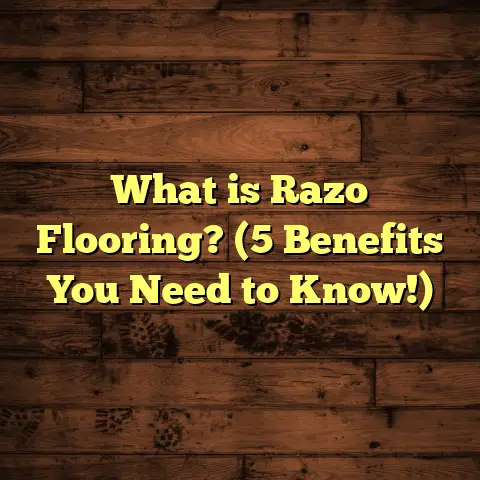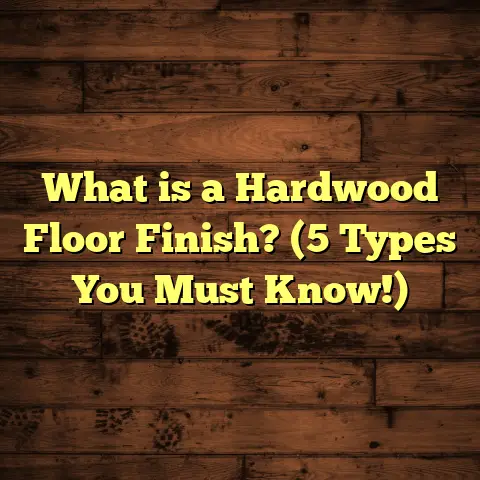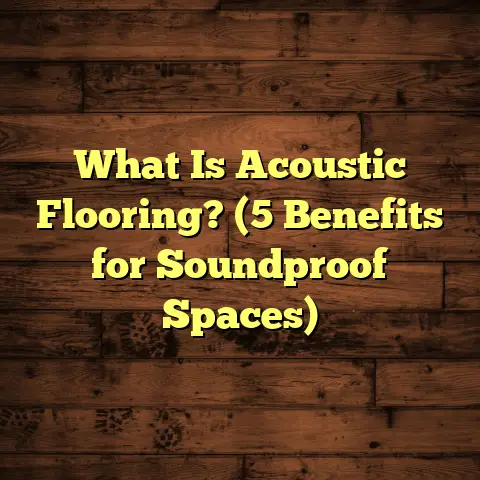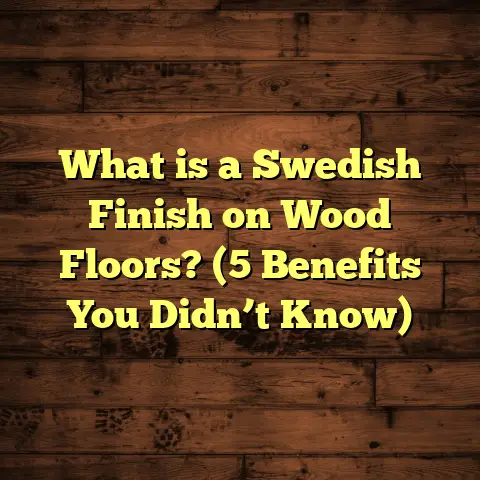What is a Linear Foot of Flooring? (5 Key Facts You Need)
I’ve been working in flooring for over a decade now, and one thing I can tell you straight up is this: understanding what a linear foot means can save you a ton of hassle, time, and money on your flooring project. It’s amazing how many people get tripped up by this simple measurement, and honestly, I’ve lost count of the projects where clients ended up short on materials, or worse, way over budget because they didn’t grasp this concept fully.
If you’re planning to buy flooring or have it installed, you need to get this down cold. Misunderstanding linear feet isn’t just a minor detail—it can change everything from how much material you buy to how the floor finally looks once it’s laid down. I’ve been there myself, early in my career, when I underestimated the importance of linear feet and had to scramble to fix mistakes that could have been avoided with a little knowledge.
So, let me walk you through exactly what a linear foot is in flooring terms, why it matters so much, how to calculate your needs correctly, and what pitfalls to avoid. Along the way, I’ll share some stories from real jobs I’ve done and provide data-backed tips that will help you make smarter decisions. Ready? Let’s go.
What Is a Linear Foot of Flooring?
At its core, a linear foot is simply a measure of length equal to 12 inches—one foot in a straight line. When you hear someone say “linear foot,” think about measuring something from end to end in a straight line.
When it comes to flooring, this measurement is usually used for materials that come in long strips or planks—like hardwood floors, vinyl planks, or laminate boards. Instead of selling these materials by the square foot (which measures area), sellers often price them by the linear foot because the length varies while the width remains fixed.
If you imagine a single plank of hardwood flooring that’s 8 feet long and 6 inches wide, the linear foot measurement refers only to that 8-foot length. It doesn’t factor in the width or thickness of the plank.
Here’s an important point that trips people up: linear feet measure only length, not area. So if you want to know how much space that plank covers on your floor, you must multiply the linear feet by the width (in feet) to get square footage.
For example:
- A plank 6 inches wide (which is 0.5 feet)
- And 8 linear feet long
The total area coverage is:
$ 8 \text{ linear feet} \times 0.5 \text{ feet} = 4 \text{ square feet} $
This is why knowing the width of your flooring plank is crucial when you buy material priced by linear foot.
Why Do Flooring Companies Use Linear Feet?
You might be wondering why some flooring materials are sold by linear foot instead of by square foot. That’s something I’ve often explained to my clients because it affects how you plan your purchase.
Here’s the deal:
- Some flooring products come in standard widths but variable lengths. For instance, engineered hardwood and vinyl planks often are manufactured in fixed widths but sold in lengths that vary from 2 feet to 8 feet (or more).
- Pricing by linear foot simplifies things for manufacturers since they don’t have to calculate price per plank piece or by area.
- It also allows buyers to order exactly how long they want the planks to be if custom lengths are available.
But here’s the catch: if you’re not careful and don’t understand this pricing method, you might think you’re buying enough flooring for your room based on square footage only — ignoring plank width — which can lead to ordering too little material.
Real-Life Example from My Experience
I remember working on a beautiful hardwood floor installation for a client’s living room. The client called me up saying they bought “100 linear feet” of hardwood planks and wanted me to install them.
I asked about the width of those planks — turns out they were 3 inches wide. The room was roughly 200 square feet.
I told them upfront: “You might be short on material.” Here’s why:
- At 3 inches wide (0.25 feet), 100 linear feet covers: 100×0.25=25 square feet100 \times 0.25 = 25 \text{ square feet}
That’s nowhere near the 200 square feet needed!
The client had confused linear feet with square footage entirely. We had to reorder much more flooring urgently, which delayed the project and increased costs.
This story pops up often because people don’t realize linear feet only measures length—not area.
How to Calculate Flooring Requirements Using Linear Feet
Getting your calculations right can feel tricky if you’re new to this, but once you nail the process, it becomes second nature.
Follow these steps:
Step 1: Measure Your Room
Start by measuring the length and width of the room or area where you want new flooring.
Example:
- Length = 15 feet
- Width = 12 feet
Total square footage:
$ 15 \times 12 = 180 \text{ sq ft} $
Step 2: Know Your Flooring Plank Dimensions
Check the product specs for your chosen flooring. You want to know:
- Width of each plank/strip (in inches or feet)
- Length of each plank (usually varies but check average or standard size)
Say your planks are 6 inches wide (0.5 feet).
Step 3: Calculate Linear Feet Needed
Use this formula:
$ \text{Linear Feet Needed} = \frac{\text{Room Area (sq ft)}}{\text{Plank Width (ft)}} $
Using our example:
$ \frac{180}{0.5} = 360 \text{ linear feet} $
This means you need about 360 linear feet of these planks to cover the entire room.
Step 4: Add Waste Factor
Plan for extra material due to cutting, fitting around corners, mistakes, and future repairs.
Waste factor recommendations vary but usually fall between 5% and 15% depending on complexity.
If you add 10% waste:
$ 360 \times 1.10 = 396 \text{ linear feet} $
Order roughly 400 linear feet to be safe.
Why Waste Factor Matters
I once installed flooring in an older home with lots of nooks and odd angles. We ended up using nearly 15% extra material compared to what the room’s dimensions suggested because every cut had to fit perfectly around doorways and cabinets.
Not accounting for waste upfront means you either:
- Run out mid-job and face delays
- Try to stretch material thin and end up with sloppy cuts or gaps
Both situations cost more money and frustration than ordering a little extra upfront.
Comparing Linear Foot Pricing vs Square Foot Pricing
I often get asked why some flooring products are priced by linear foot while others are priced by square foot. Understanding this difference helps you budget better.
Linear Foot Pricing
- Common with hardwood strips, vinyl planks, and other long strip materials.
- Works when width is fixed and length varies.
- You pay for length only; width influences total coverage but isn’t part of the price calculation.
- Can be confusing if you don’t know plank width.
Square Foot Pricing
- More common for tiles, carpet rolls, vinyl sheets.
- You pay for total area coverage regardless of plank size.
- Easier for customers who think in terms of room size.
- Sometimes less flexible if planks come in non-standard sizes.
Data Insight from Industry Sources
According to market research from Floor Focus Magazine (2023), about 65% of hardwood flooring products sold in the U.S. are priced by linear foot due to standard plank widths and variable lengths.
On the other hand:
- Carpet and vinyl sheet flooring pricing by square foot dominates due to continuous roll goods.
- Laminate flooring prices are mixed but lean towards square footage for simplicity.
My Personal Story: Learning From Mistakes
Early in my career, I worked on a commercial office flooring project where we ordered laminate flooring by square footage alone without checking plank dimensions carefully.
The planks were narrower than expected—only about 4 inches wide—and we ended up needing nearly twice as many linear feet as originally planned. The supplier had quoted price per square foot but didn’t emphasize how width affected total quantity needed.
This oversight added thousands of dollars in last-minute orders and delayed installation by a week.
Since then, I always double-check plank dimensions when ordering materials priced per linear foot or square foot—and I recommend clients do the same.
Five Key Facts You Need About Linear Feet in Flooring
Let me break down the five most important things you need to remember about linear feet when dealing with flooring:
1. Linear Feet Only Measure Length
It doesn’t include width or thickness—just how long your plank is from end to end.
2. Width Is Critical for Calculating Coverage
To convert linear feet into square footage (area), multiply linear feet by plank width (in feet).
3. Waste Factor Is Non-Negotiable
Add at least 5–15% extra material for cuts, mistakes, and complex layouts.
4. Different Flooring Types Use Different Pricing Models
Hardwood often uses linear foot pricing; carpet uses square footage; vinyl can be either depending on product form.
5. Accurate Measurement Saves Money and Hassle
Know your room size + plank dimensions + waste factor before shopping or ordering material.
Case Study: Hardwood vs Vinyl Flooring Pricing Breakdown
I recently helped two clients with similar-sized rooms (~250 sq ft) but different flooring choices:
Hardwood Client
- Plank width: 5 inches (0.42 ft)
- Price per linear foot: $10
- Linear feet needed (including waste): 2500.42×1.1≈654 linear feet\frac{250}{0.42} \times 1.1 \approx 654 \text{ linear feet}
Total cost:
$ 654 \times $10 = $6,540 $
Vinyl Client
- Vinyl planks priced at $4 per square foot
- Total cost for room + waste: 250×1.1×$4=$1,100250 \times 1.1 \times \$4 = \$1,100
This shows how pricing models differ widely based on material type—but understanding linear foot measurement helps even out expectations when comparing costs.
How Tools Like FloorTally Help You Nail Measurements and Costs
In my work as a contractor, I rely on tools like FloorTally regularly because they simplify these calculations by taking your inputs—room size, plank dimensions, local labor rates—and giving realistic cost estimates including waste factors.
FloorTally’s breakdown helps prevent surprises like ordering too little or budgeting too low. If you’re planning DIY or hiring pros, using such calculators can give peace of mind before buying materials.
What About Carpet? Does Linear Foot Apply?
Great question! Carpet is usually sold by square yard or square foot, but sometimes carpet strips or borders are priced by linear foot.
For example:
- Carpet borders around rooms or stair edges come in rolls measured linearly.
- If buying carpet remnants or strips for a runner, sellers might quote price per linear foot based on roll width.
So while carpet mostly deals with area measurements, linear foot pricing does show up occasionally depending on product type.
Thickness vs Width vs Length: Why Each Dimension Matters
Let me clear this up because I’ve seen confusion here too:
- Length (linear foot) = How long your plank or strip is.
- Width = How wide your plank is.
- Thickness = How thick your plank is (affects durability but not coverage).
Only length matters for linear feet measurement directly. Width affects coverage calculation indirectly because coverage = length × width.
Thickness matters mostly for installation decisions—not calculating materials needed.
Common Mistakes I’ve Seen Around Linear Feet and Flooring
Here are some pitfalls from my experience that homeowners should avoid:
Mistake #1: Confusing Linear Feet With Square Feet
Ordering “100 linear feet” when you really need enough material to cover a certain square footage room leads to huge shortages.
Mistake #2: Ignoring Plank Width When Calculating Coverage
People buy planks without factoring in how narrow widths reduce total coverage per linear foot.
Mistake #3: Skipping Waste Factor
Cutting corners on waste can cause delays and extra costs later during installation.
Mistake #4: Not Verifying Pricing Method Before Purchase
Some suppliers quote price per linear foot; others per square foot—knowing which saves money and confusion.
What Flooring Types Are Typically Sold By Linear Foot?
Here’s a quick rundown from my projects:
| Flooring Type | Usually Sold By |
|---|---|
| Hardwood Planks | Linear Foot |
| Engineered Hardwood | Linear Foot |
| Vinyl Planks | Linear Foot |
| Laminate Flooring | Square Foot / Occasionally Linear Foot |
| Carpet Rolls | Square Yard / Square Foot |
| Carpet Borders/Strips | Linear Foot |
| Tile | Square Foot |
Knowing this helps you ask the right questions when shopping or budgeting for your project.
What About Installation Costs? Does Linear Foot Affect Pricing?
You might wonder whether installers charge by linear foot or square foot. It varies:
- For strip hardwood floors installed plank-by-plank, installers often quote labor costs per linear foot since installation time relates closely to plank length.
- For carpet or tile installations covering large areas, labor is usually charged per square foot.
In my experience working with contractors across different states:
- Hardwood installation labor rates average about $3–$7 per linear foot.
- Vinyl or laminate installation labor typically charges $1–$3 per square foot.
Knowing these differences helps when comparing quotes from pros.
How Different Room Shapes Affect Linear Foot Calculations
Straight rectangular rooms are easiest—you just multiply length × width then convert using plank width as explained earlier.
But what about oddly shaped rooms? Or rooms with cutouts for closets or fireplaces?
These can increase waste significantly because fitting planks around corners requires more cuts and scrap pieces.
I always recommend measuring each section separately, calculating total needed linear feet per section, then summing them up before adding waste factor.
For example:
- Living room main area: 150 sq ft
- Adjacent nook: 30 sq ft
Calculate separately then combine results before ordering material.
Failing to do this means underordering materials for complex spaces—a mistake I’ve helped clients fix time after time.
Final Thoughts on Linear Foot Measurements for Flooring
Over years of installing floors and advising customers, I can say confidently:
Understanding what a linear foot means and how it relates to plank width and total coverage is essential before ordering any strip-style flooring product.
Getting this right upfront avoids costly errors like running out mid-project or overspending unnecessarily. Adding an appropriate waste factor based on your room shape keeps installation smooth and stress-free.
If you’re ever unsure about calculations or pricing models—don’t hesitate to use online calculators like FloorTally or reach out to pros who can guide your purchase precisely based on your project needs.
Remember these key points:
- Measure your room accurately.
- Know your plank dimensions inside out.
- Use formulas combining length and width for total coverage.
- Add at least 10% material waste.
- Confirm pricing units before ordering.
With these tips in hand, your next flooring project will be set up for success from day one!
If you want help planning your next project, feel free to ask me about specific materials or calculations—I’m here to make sure your floors look fantastic without surprises along the way!





